How To Remove Ring Shank Nails
How to Remove Stuck Nails: Hammer Tips
Updated: Jun. 30, 2017
Stubborn boom got you lot stumped? Try these tricks for pulling the toughest nails.
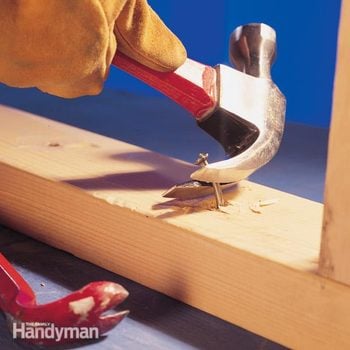
Acquire to pull bent or errant nails speedily and efficiently with your hammer, a cat'due south mitt, nippers, and a woods block, or cut them with a reciprocating saw. You tin can remove them without damaging surrounding materials.
You lot might also like: TBD
Technique one: Maximize your hammer power
Back when I was a rookie garage-builder, the lead carpenter warned me that driving a nail almost a knot is a waste matter of fourth dimension for three reasons: First, the nail volition bend in the dense woods surrounding the knot earlier you tin can drive it home. Second, it'll be solidly wedged in the wood and tough to pull out. And third, you could intermission a hammer handle tugging at it.
I was stubborn and had to learn past experience. But I never broke a hammer handle, because I started out with an unbreakable all-steel model. Past the fourth dimension I graduated to a nicely balanced wooden-handled model, I'd learned how to pull nails chop-chop and efficiently enough to hardly suspension my nailing rhythm.
A hammer isn't the all-time nail-pulling tool, just since it'southward already in your mitt, use it. Ram the claw into the nail shank every bit close every bit possible to the wood and rock it sideways (Photograph one). Then repeat the process, pulling the nail well-nigh i/2 in. each time. Y'all develop terrific pulling power, enough to excerpt even those tough cement-coated or galvanized nails, without straining your hammer handle or arm.
Because the hammer claw grabs the nail's shank, this method unremarkably works even when the smash head has broken off. But it has a couple of drawbacks. The edge of the head will bite into and dent the wood. If you lot don't want to mar the surface, slide a i/four-in.-thick piece of woods under the edge before pulling. Also, a worn claw might slip on the shank and not deliver whatever pull. And finally, the pulling power tin be so neat that the nail shank might break before the boom lets go. At that point, either clip information technology flush to the wood with a side-cut pliers and exit it, or saw through information technology (Photo five).
Technique 2: Protect those finished surfaces with a block
Shove a block of scrap forest nether the hammer caput to protect delicate surfaces, like the cedar decking in Photograph 2. The block also gives the hammer claw better leverage, so you can ofttimes rock the hammer directly back on its head rather than sideways. But not e'er. Apply this directly pull only on nails that come out fairly easily or aren't driven deeply. Otherwise you could break a wooden-handled hammer. Although you can yank a lot harder on hammers with a fiberglass or steel handle, you'll observe information technology's a lot easier to utilize a sideways pull.
Technique 3: Dig for buried nails
Buried nails are no match for a cat'southward paw, an essential tool to deport for all rough framing work. Emphasize "crude," because you lot drive the claw under the cached nailhead and stone the handle back firmly (Photo 3). The short claw develops tremendous leverage and volition pull about any boom. A strong, steady pull works best. If y'all jerk the handle, y'all could pop the caput off the smash, particularly with 16d galvanized nails. Y'all tin employ it for bent nails also. But you have to put a block under the cat's manus to develop good leverage, as in Photograph 2, or slide your hammer caput nether it to shim it upwardly.
Drawback: Even with a deft touch on, the cat's paw digs upward a divot of woods effectually the nailhead and leaves a singled-out "paw impress" behind when y'all rock information technology back. It's not a finish tool.
Technique 4: Bulldoze it through
Finish carpentry sometimes calls for more refined tactics to avert ruining a valuable piece of woodwork. You can pull almost bent finish nails with the hammer-and- cake technique shown earlier or with pliers.
Only if you can't pry trim off without damaging it, drive the stop nails completely through the trim (Photo iv) and popular it off. You can use either a 1/32-in. nail set or a ane/16-in. pivot punch (buy at domicile centers and hardware stores). They are especially handy for releasing window and door casings that take been cantankerous-nailed to hold the miters together.
Drawbacks: Use the nail set for sparse woodwork. Otherwise, you lot'll leave a fairly large round hole on the front side to fill subsequently. And work advisedly near ends, because the boom set can split the wood.
Technique 5: Cut the tough ones
A reciprocating saw can cut through nails in a fraction of the fourth dimension information technology takes to pull them (Photograph 5). Plus it'll achieve nails you tin can't become at any other manner. Many all-purpose blades cut both woods and nails, simply buy the 10-teeth-per-inch type considering it cuts through hardened drywall screws likewise. With a deft touch, yous tin also practice delicate work, like reaching behind trim to cut nails, as well as screws and bolts, without marring the wood.
Drawback: Chances are that the blade will pinch while cutting tight spots, so push the saw guard tightly against the woods and hold the saw firmly.
Technique 6: Pull them from the back
Stop trim is expensive and worth salvaging whenever possible. If you can pry it off, pull the finish nails from the backside (Photo 6). They'll splinter the front if you lot drive them back through. A nippers works well, but so do sideslip-articulation pliers and locking pliers.
Required Tools for this Project
Have the necessary tools for this DIY project lined up before you lot start—you'll salvage fourth dimension and frustration.
Originally Published: June 20, 2017
Source: https://www.familyhandyman.com/project/how-to-remove-stuck-nails-hammer-tips/

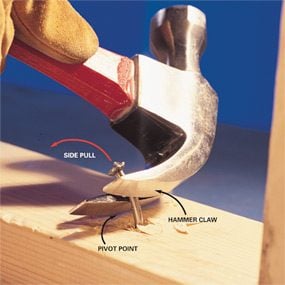
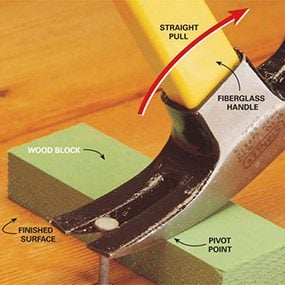
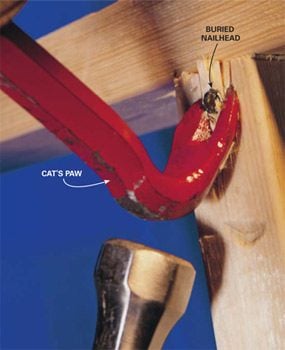
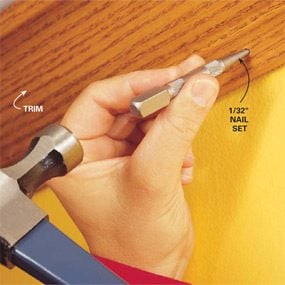


0 Response to "How To Remove Ring Shank Nails"
Post a Comment